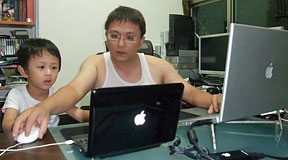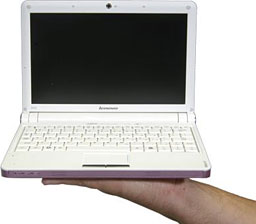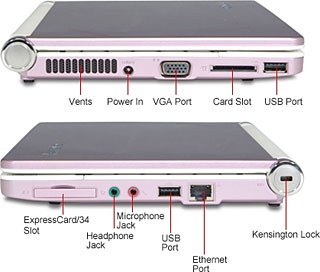I continue to be intrigued and enticed by PC netbooks marketed by
Asus, MSI, Lenovo, and even Dell. I wish Apple could be persuaded to
enter this field with a competitive and non-connectivity and
upgradability-crippled entry.
I'm probably fantasizing in futility, but it doesn't hurt to
dream.
It's even got me musing about getting a netbook and running Linux on
it, although an article late last week on ecmarchitect.com
pours a bit of reality-check cold water on that idea. This all does
underscore, however, that for me at least, the primary reason I am a
Mac user is the Mac OS and not the hardware, as nice as the latter can
be.
Not Alone
I'm not alone in my netbook frustration. A fellow Mac columnist, who
shall remain anonymous, says:
"Call me stupid, but I may get one. Only because I'm
stupid. No. I actually think I need a Windows machine. You can't beat
that price. And I can hide it quickly if someone comes in. 'Was that a
PC I just saw you using?' I can say 'No, what are you talking about?'
. . . Apple HAS to do something about their pricing or they
will never command the market in the way they want to." . . .
I know it's not allowed, but OS X on that little MSI would be
cool."
 Some folks are already
doing that.
Some folks are already
doing that.
eWeek's Joe Wilcox
reported recently that some people so badly want an Apple-branded
netbook that they're willing to make their own, referencing a MacRumors
post about an apparently home-built "unofficial" MacBook nano with a
link to a Flickr gallery.
"It's hard to believe that this isn't a real
Apple-branded netbook, because the workmanship is so good. A second
gallery shows the transformation: From MSI netbook to MacBook
nano."
"The transformation is quite amazing to see. Removal
of the MSI logo, replaced with Apple logo and swapping out some keys
for those found on Apple laptops."
I saw the photo on MacRumors too and drooled a bit. If Apple built a
machine like this (including the hacked mockup's generous 320 GB hard
drive and generous array of I/O ports), and offered it in the $600 to
$800 range that high-end PC netbooks sell for, I would find it hard to
resist.
I should note here that Apple could have pre-empted a lot of my
pining for a Mac netbook if they'd properly equipped the new Unibody MacBook with FireWire
and the range of other I/O ports and slots that are routinely found on
PC netbooks.
While the price of PC netbooks appeals to my parsimonious streak,
and the miniaturization appeals to me aesthetically, from a functional
and actual need perspective, laptop size is not a crucial factor for
me. I got along quite happily for three years using a 12" iBook as my primary
workhorse, but then switched to a 17" PowerBook, whose size is
not a drawback for most of what I do with it, although the iBook was
obviously a more convenient rig on the road.
However, Joe Wilcox observes that netbooks are hot right now, so
maybe Apple should take this enthusiast's handiwork as a cue to get
moving on making an official Mac netbook. I couldn't agree more.
However, I draw the line at doing an unauthorized OS X install on
a PC laptop.
The Netbook Market
PCMag's Dan Costa asks and
answers the rhetorical question "Netbooks are cheap and easy to
tote, but will they replace notebooks?" by hitting the road with a
HP Mini
1000 netbook in tow, noting that the netbook doesn't get you online
any easier than a notebook, it just does it less expensively. It's also
much easier to slip into a carryon bag. On the other hand, he found the
Mini 1000's Intel Atom processor suitable only for light-medium duty
computing tasks, the battery life unimpressive, and the the 10" screen
is a bit limiting. Still, he concludes, while the traditional-sized
notebook is here to stay, it's more likely to stay behind, docked and
loaded with its high-end features, while the netbook takes over road
warrioring tasks.
CameraHacker.com's Chieh Cheng
observes that "Netbooks are photographers' and cinematographers'
dream. For four hundred dollars, you can get one with a decent
processor, lots of memory, 60 GB of hard drive space, memory card
reader, USB ports, and WiFi. You can get all these in a Netbook less
then three pounds, such as the Acer Aspire One. For photographers
and cinematographers who like to travel lightly, it is highly desirable
to travel with this kind of notebook computer.
 Lenovo IdeaPad
Lenovo IdeaPad
He also notes that one critical element missing most netbooks is a
FireWire (IEEE 1394) port, but that the
Lenovo IdeaPad S10-1208U netbook, which he found available at
TigerDirect.com for all of $399.99 (also available from J&R
Computer World in
black,
white, or
red for the same price), does have an ExpressCard slot.
 The Lenovo IdeaPad S10-1208U weighs 2.76 lb. including battery,
is about 1" thick, has the usual 1.6 GHz Intel Atom Processor, an Intel
Graphics Media Accelerator 950, an 80 GB hard drive, 512 GB of memory
(upgradable to 1.5 GB), a 4-in-1 media reader, 802.11 b/g wireless, a
10.2" screen with 1024 x 600 resolution, 2 USB ports, an ExpressCard 34
Slot, a VGA video port, audio in and out jacks, and an integrated
webcam, plus a swappable battery and easy access to the battery bay and
RAM slot.
The Lenovo IdeaPad S10-1208U weighs 2.76 lb. including battery,
is about 1" thick, has the usual 1.6 GHz Intel Atom Processor, an Intel
Graphics Media Accelerator 950, an 80 GB hard drive, 512 GB of memory
(upgradable to 1.5 GB), a 4-in-1 media reader, 802.11 b/g wireless, a
10.2" screen with 1024 x 600 resolution, 2 USB ports, an ExpressCard 34
Slot, a VGA video port, audio in and out jacks, and an integrated
webcam, plus a swappable battery and easy access to the battery bay and
RAM slot.
 Why can't Apple make a small notebook like this?
Why can't Apple make a small notebook like this?
Asus Eee PC
A couple of months ago, I wrote here about Asustek's
stylish new Eee PC S101 model, an upmarket netbook available in three
attractive colors - brown, champagne, and graphite - in a package
weighing just 1 kg (2.4 lb.) and 18-25 cm (0.7-1.0") thick. Asus touts
the S101 as the "pinnacle of netbook computing." And while it comes at
a higher price - $699 - than the regular Eee PC, it's lighter, nearly
as thin, and a lot cheaper than a MacBook Air. In my opinion, it
looks nicer and has a much more practical and real-world useful
specification.
 To recap,
the S101 trounces the Air in most aspects and features (although
neither has FireWire or an ExpressCard slot) supporting not only WiFi
802.11n and Bluetooth 2.0 connectivity, but also including a VGA port
(D-sub 15-pin for external monitor), 3 USB 2.0 ports (to the MacBook
Air's overworked single USB port), a real RJ-45 ethernet port, analog
headphone and mic-in jacks, a 0.3 megapixel (MP) camera, a 4-in-1 card
reader (MMC, SD, Memory Stick, and MS-PRO flash card), built-in stereo
speakers, and a digital array mic. Its 36 W/hr; 2S2P (2450 mAh/cell)
Polymer battery is slide-in replaceable (you can change the battery
yourself without undoing 19 screws) and offers a claimed "up to five
hours" of continuous use.
To recap,
the S101 trounces the Air in most aspects and features (although
neither has FireWire or an ExpressCard slot) supporting not only WiFi
802.11n and Bluetooth 2.0 connectivity, but also including a VGA port
(D-sub 15-pin for external monitor), 3 USB 2.0 ports (to the MacBook
Air's overworked single USB port), a real RJ-45 ethernet port, analog
headphone and mic-in jacks, a 0.3 megapixel (MP) camera, a 4-in-1 card
reader (MMC, SD, Memory Stick, and MS-PRO flash card), built-in stereo
speakers, and a digital array mic. Its 36 W/hr; 2S2P (2450 mAh/cell)
Polymer battery is slide-in replaceable (you can change the battery
yourself without undoing 19 screws) and offers a claimed "up to five
hours" of continuous use.
 The Asus
machine comes with Solid State Drive (SSD) storage in capacities of up
to 64 GB (16 GB for the Windows version, 32 GB or 64 GB available with
the Linux version), 1 GB of RAM, and a 10.2" active matrix LED-backlit
1024 x 600 (almost 16:9) display.
The Asus
machine comes with Solid State Drive (SSD) storage in capacities of up
to 64 GB (16 GB for the Windows version, 32 GB or 64 GB available with
the Linux version), 1 GB of RAM, and a 10.2" active matrix LED-backlit
1024 x 600 (almost 16:9) display.
Of course, what the Eee PC S101 doesn't have is the Mac OS, being
available with either Microsoft Genuine Windows XP Home or GNU Linux,
and it gets along with a relatively poky 1.6 GHz Intel Atom processor
and and two-generations-ago Intel 945 Express (GMA 950) integrated
graphics, as opposed to the latest MacBook Air's full-fledged Core 2
Duo CPU, 120 GB hard drive, and much faster Nvidia GeForce 9400M
integrated graphics.
 The
MacBook Air's strong points competitively are the Mac OS, a larger
display (13.3" 1280 x 800 resolution), a Core 2 Duo processor, the much
better graphics support, and a full-sized keyboard, but you could buy
two S101s for the price of one MacBook Air. Apple also made too many
compromises with connectivity, expandability, and practicality in their
quest to make the MacBook Air fit comfortably inside a manila envelope,
resulting in a machine that I wouldn't even consider owning (unless I
became unexpectedly flush with disposable income and could afford one
as an engaging toy), while the much-cheaper Asus S101 is a real
computer that I could conceive of using for the same sort of production
work that I do now with my old Pismo PowerBooks.
The
MacBook Air's strong points competitively are the Mac OS, a larger
display (13.3" 1280 x 800 resolution), a Core 2 Duo processor, the much
better graphics support, and a full-sized keyboard, but you could buy
two S101s for the price of one MacBook Air. Apple also made too many
compromises with connectivity, expandability, and practicality in their
quest to make the MacBook Air fit comfortably inside a manila envelope,
resulting in a machine that I wouldn't even consider owning (unless I
became unexpectedly flush with disposable income and could afford one
as an engaging toy), while the much-cheaper Asus S101 is a real
computer that I could conceive of using for the same sort of production
work that I do now with my old Pismo PowerBooks.
Last week The Register's Will Head posted a
thorough review of the S101, where he notes that it really is a
serious computer, observing that "everything about it looks fantastic -
from even the carefully designed box to its shiny gloss finish" (plus
an included plush slip case and handy polishing cloth). He reports that
the keys are a bit on the small side, especially if you have large
fingers, but with a little practice not that difficult to type on, and
you do get a real keyboard with a full complement of function keys
along the top, as well as a two-button trackpad that is surprisingly
large for such a small machine.
Even better perhaps was the revelation that hard drive performance
was astonishingly good, with it coming in at almost twice as fast as
the closest contender, and battery life was also pretty impressive,
lasting 178 minutes playing The Reg's standard-definition test
video full screen on repeat, and 208 minutes - three and three-quarter
hours - with the processor throttled down to 800 MHz. Head estimates a
good five or six hours battery life under more typical netbook
usage.
Access to the wireless card and memory slots is one screw away,
underneath a user accessible hatch, and the memory is upgradable,
unlike the MacBook Air's.
If Only....
If the S101 was (legally) supported by Mac OS X, I would definitely
have trouble resisting, but the little Lenovo IdeaPad S10-1208U has me
thinking more.

 Some folks are already
doing that.
Some folks are already
doing that. Lenovo IdeaPad
Lenovo IdeaPad The Lenovo IdeaPad S10-1208U weighs 2.76 lb. including battery,
is about 1" thick, has the usual 1.6 GHz Intel Atom Processor, an Intel
Graphics Media Accelerator 950, an 80 GB hard drive, 512 GB of memory
(upgradable to 1.5 GB), a 4-in-1 media reader, 802.11 b/g wireless, a
10.2" screen with 1024 x 600 resolution, 2 USB ports, an ExpressCard 34
Slot, a VGA video port, audio in and out jacks, and an integrated
webcam, plus a swappable battery and easy access to the battery bay and
RAM slot.
The Lenovo IdeaPad S10-1208U weighs 2.76 lb. including battery,
is about 1" thick, has the usual 1.6 GHz Intel Atom Processor, an Intel
Graphics Media Accelerator 950, an 80 GB hard drive, 512 GB of memory
(upgradable to 1.5 GB), a 4-in-1 media reader, 802.11 b/g wireless, a
10.2" screen with 1024 x 600 resolution, 2 USB ports, an ExpressCard 34
Slot, a VGA video port, audio in and out jacks, and an integrated
webcam, plus a swappable battery and easy access to the battery bay and
RAM slot. Why can't Apple make a small notebook like this?
Why can't Apple make a small notebook like this? To recap,
the S101 trounces the Air in most aspects and features (although
neither has FireWire or an ExpressCard slot) supporting not only WiFi
802.11n and Bluetooth 2.0 connectivity, but also including a VGA port
(D-sub 15-pin for external monitor), 3 USB 2.0 ports (to the MacBook
Air's overworked single USB port), a real RJ-45 ethernet port, analog
headphone and mic-in jacks, a 0.3 megapixel (MP) camera, a 4-in-1 card
reader (MMC, SD, Memory Stick, and MS-PRO flash card), built-in stereo
speakers, and a digital array mic. Its 36 W/hr; 2S2P (2450 mAh/cell)
Polymer battery is slide-in replaceable (you can change the battery
yourself without undoing 19 screws) and offers a claimed "up to five
hours" of continuous use.
To recap,
the S101 trounces the Air in most aspects and features (although
neither has FireWire or an ExpressCard slot) supporting not only WiFi
802.11n and Bluetooth 2.0 connectivity, but also including a VGA port
(D-sub 15-pin for external monitor), 3 USB 2.0 ports (to the MacBook
Air's overworked single USB port), a real RJ-45 ethernet port, analog
headphone and mic-in jacks, a 0.3 megapixel (MP) camera, a 4-in-1 card
reader (MMC, SD, Memory Stick, and MS-PRO flash card), built-in stereo
speakers, and a digital array mic. Its 36 W/hr; 2S2P (2450 mAh/cell)
Polymer battery is slide-in replaceable (you can change the battery
yourself without undoing 19 screws) and offers a claimed "up to five
hours" of continuous use. The Asus
machine comes with Solid State Drive (SSD) storage in capacities of up
to 64 GB (16 GB for the Windows version, 32 GB or 64 GB available with
the Linux version), 1 GB of RAM, and a 10.2" active matrix LED-backlit
1024 x 600 (almost 16:9) display.
The Asus
machine comes with Solid State Drive (SSD) storage in capacities of up
to 64 GB (16 GB for the Windows version, 32 GB or 64 GB available with
the Linux version), 1 GB of RAM, and a 10.2" active matrix LED-backlit
1024 x 600 (almost 16:9) display. The
MacBook Air's strong points competitively are the Mac OS, a larger
display (13.3" 1280 x 800 resolution), a Core 2 Duo processor, the much
better graphics support, and a full-sized keyboard, but you could buy
two S101s for the price of one MacBook Air. Apple also made too many
compromises with connectivity, expandability, and practicality in their
quest to make the MacBook Air fit comfortably inside a manila envelope,
resulting in a machine that I wouldn't even consider owning (unless I
became unexpectedly flush with disposable income and could afford one
as an engaging toy), while the much-cheaper Asus S101 is a real
computer that I could conceive of using for the same sort of production
work that I do now with my old
The
MacBook Air's strong points competitively are the Mac OS, a larger
display (13.3" 1280 x 800 resolution), a Core 2 Duo processor, the much
better graphics support, and a full-sized keyboard, but you could buy
two S101s for the price of one MacBook Air. Apple also made too many
compromises with connectivity, expandability, and practicality in their
quest to make the MacBook Air fit comfortably inside a manila envelope,
resulting in a machine that I wouldn't even consider owning (unless I
became unexpectedly flush with disposable income and could afford one
as an engaging toy), while the much-cheaper Asus S101 is a real
computer that I could conceive of using for the same sort of production
work that I do now with my old 
